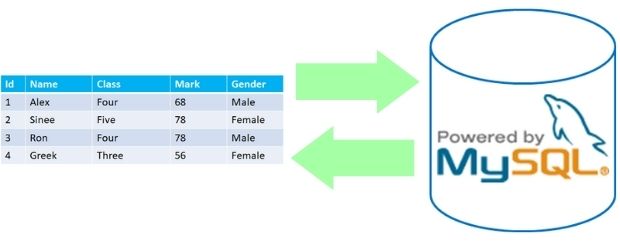to_sql to Pass data from DataFrame to MySQL

We will use sqlalchemy and its create_engine to manage our database connection from Python to MySQL. For this we need to install mysqlclient. All details of installation are given at our MySQL installation page.
Inserting DataFrame to MySQL database table by using to_sql() from Excel or CSV sources
Installing mysqlclient with connection string
Use the SQL dump to create student table with sample data.
from sqlalchemy import create_engine
my_conn = create_engine("mysql+mysqldb://userid:password@localhost/my_database") #fill details
my_conn=my_conn.connect() # add this line if error Sample code to create table
Using this DataFrame we will create a new table in our MySQL database. Here df is our DataFrame.df.to_sql(con=my_conn,name='student2',if_exists='append')name
Name of the Database table.con
Connection to Database.if_exists
If the table is already available then we can use if_exists to tell how to handle. It can take three values, fail( default), replace, append.fail: (default) Generate a value errorreplace: Drop the table and then insert new valuesappend : Add new data to the table.
index
You can see in above display , the first column is our DataFrame index. This also by default goes to our table. We can stop this by setting index=Falseindex:(optional) Boolean , if True ( default ) index will be added to the table, in case of False no index will transfer along with records.
df.to_sql(con=my_conn,name='student2',if_exists='append', index=False)OperationalError: (MySQLdb._exceptions.OperationalError) (1054, "Unknown column 'index' in 'field list'")index_label
Column Label we can use for index column.chunksize
Number of rows to be written at a time. By default all rows are written at one go. Used for large number of rows.dtypedict or scalar, optional
Specifying the datatype for columns. If a dictionary is used, the keys should be the column names and the values should be the SQLAlchemy types or strings for the sqlite3 legacy mode. If a scalar is provided, it will be applied to all columns.from sqlalchemy import create_engine,Floatdf.to_sql(con=my_conn,name=d,if_exists='replace',
index=False,dtype={"Sp_Mobile": Float,"Sp_Desktop":Float}) Handling Date & time column
If you have Date field then you can change the column to Y-m-d format to store in mysql table.my_data['c_date']=pd.to_datetime(my_data['c_date'],format='%d.%m.%Y')Read more on how to convert to datetime field by using to_datetime()
When to use ignore and coerce in to_datetime().
If our column has blank data ( specially when reading from Excel file ) and we want to continue with rest of the data then better to use errors='coerce'. By using ignore we may not able to convert to datatime format for all the rows.Excel to MySQL

import pandas as pd
df = pd.read_excel('D:\emp.xlsx')
# reading data from root of D drive.
from sqlalchemy import create_engine
my_conn = create_engine("mysql+mysqldb://userid:pw@localhost/db_name")
### Creating new table emp or appending existing table
df.to_sql(con=my_conn,name='emp',if_exists='append')CSV file to MySQL
import pandas as pd
from sqlalchemy import create_engine
my_conn = create_engine("mysql+mysqldb://userid:pw@localhost/db_name")
df = pd.read_csv("F:\\data\\student.csv") # Path of the csv file, create dataframe
df.to_sql(con=my_conn, name="student5", if_exists="append")CSV file to SQLite database table
Read more on SQLite database table .Read more on Downloading Kaggle dataset ( Titanic ) to Colab
import pandas as pd
import sqlite3
# Name of the CSV file to convert
csv_file = 'Titanic-Dataset.csv'
# Name of the SQLite database file to create
db_file = 'titanic.db'
# Name of the table within the SQLite database
table_name = 'titanic_data'
# Read the CSV file into a pandas DataFrame
df = pd.read_csv(csv_file)
# Create an SQLite database connection
conn = sqlite3.connect(db_file)
# Write the DataFrame to an SQLite table
df.to_sql(table_name, conn, if_exists='replace', index=False)
# Close the connection
conn.close()
print(f"Successfully converted '{csv_file}' to SQLite database '{db_file}' with table '{table_name}'.")Questions
- How do I use the
to_sql()function in Pandas to save a DataFrame to a SQL database? - What are the required parameters for the
to_sql()function in Pandas? - Can I specify a table name while using the
to_sql()function? - What is the default behavior of the
to_sql()function when creating a table in the database? - How can I specify the data types for the columns when saving a DataFrame to a database using
to_sql()? - Is it possible to append data to an existing table in the database using the
to_sql()function? - How do I handle primary keys or unique constraints when saving a DataFrame to a database using
to_sql()? - What happens if there are duplicate column names in the DataFrame when using
to_sql()? - Can I control the chunk size or batch size for inserting data when using
to_sql()? - How can I handle errors or exceptions when saving a DataFrame to a database using
to_sql()?
Data input and output from Pandas DataFrame Download sample Excel or CSV file or create DataFrame
Pandas DataFrame read_sql read_sql_table insert data

Subhendu Mohapatra
Author
🎥 Join me live on YouTubePassionate about coding and teaching, I publish practical tutorials on PHP, Python, JavaScript, SQL, and web development. My goal is to make learning simple, engaging, and project‑oriented with real examples and source code.
Subscribe to our YouTube Channel here
This article is written by plus2net.com team.
https://www.plus2net.com

 Python Video Tutorials
Python Video Tutorials